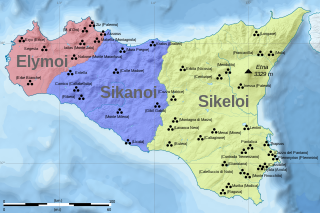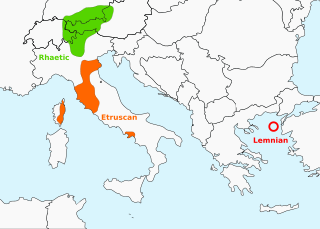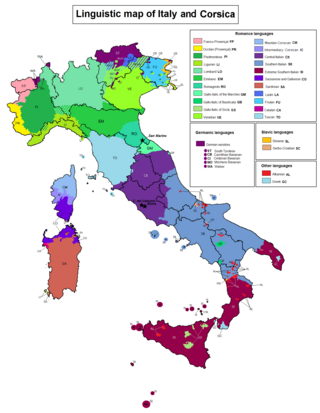
Etruscan was the language of the Etruscan civilization in the ancient region of Etruria, in Etruria Padana and Etruria Campana in what is now Italy. Etruscan influenced Latin but was eventually completely superseded by it. The Etruscans left around 13,000 inscriptions that have been found so far, only a small minority of which are of significant length; some bilingual inscriptions with texts also in Latin, Greek, or Phoenician; and a few dozen purported loanwords. Attested from 700 BC to AD 50, the relation of Etruscan to other languages has been a source of long-running speculation and study, with it mostly being referred to as one of the Tyrsenian languages, at times as an isolate and a number of other less well-known theories.

The Elymians were an ancient tribal people who inhabited the western part of Sicily during the Bronze Age and Classical antiquity.
The Camunic language is an extinct language that was spoken in the 1st millennium BC in Val Camonica, a valley in the Central Alps. The language is sparsely attested to an extent that makes any classification attempt uncertain – even the discussion of whether it should be considered a pre–Indo-European or an Indo-European language has remained indecisive. Among several suggestions, it has been hypothesized that Camunic is related to the Raetic language from the Tyrsenian language family, or to the Celtic languages.

The Lepontii were an ancient Celtic people occupying portions of Rhaetia in the Alps during the late Bronze Age/Iron Age. Recent archeological excavations and their association with the Golasecca culture and Canegrate culture point to a Celtic affiliation. From the analysis of their language and the place names of the old Lepontic areas, it was hypothesized that these people represent a layer similar to that Celtic but previous to the Gallic penetration in the Po valley. The suggestion has been made that the Lepontii may have been celticized Ligurians.

The Sicels were an Indo-European tribe who inhabited eastern Sicily, their namesake, during the Iron Age. They spoke the Siculian language. After the defeat of the Sicels at the Battle of Nomae in 450 BCE and the death of Sicel leader Ducetius in 440 BCE, the Sicel state broke down and the Sicel culture merged into Magna Graecia.

Venetic is an extinct Indo-European language, usually classified into the Italic subgroup, that was spoken by the Veneti people in ancient times in northeast Italy and part of modern Slovenia, between the Po Delta and the southern fringe of the Alps, associated with the Este culture.

Rhaetic or Raetic, also known as Rhaetian, was a Tyrsenian language spoken in the ancient region of Rhaetia in the eastern Alps in pre-Roman and Roman times. It is documented by around 280 texts dated from the 5th up until the 1st century BC, which were found through northern Italy, southern Germany, eastern Switzerland, Slovenia and western Austria, in two variants of the Old Italic scripts. Rhaetic is largely accepted as being closely related to Etruscan.

The Sicilians, or Sicilian people, are a Romance-speaking ethnic group who are indigenous to the island of Sicily, the largest island in the Mediterranean Sea, as well as the largest and most populous of the autonomous regions of Italy.

The Sicani or Sicanians were one of three ancient peoples of Sicily present at the time of Phoenician and Greek colonization. The Sicani dwelt east of the Elymians and west of the Sicels, having, according to Diodorus Siculus, the boundary with the last in the ancient Himera river (Salso) after a series of battles between these tribes.

The Gallo-Italic, Gallo-Italian, Gallo-Cisalpine or simply Cisalpine languages constitute the majority of the Romance languages of northern Italy: Piedmontese, Lombard, Emilian, Ligurian, and Romagnol. In central Italy they are spoken in the northern Marches ; in southern Italy in some language islands in Basilicata and Sicily.

The Lemnian language was spoken on the island of Lemnos, Greece, in the second half of the 6th century BC. It is mainly attested by an inscription found on a funerary stele, termed the Lemnos stele, discovered in 1885 near Kaminia. Fragments of inscriptions on local pottery show that it was spoken there by a community. In 2009, a newly discovered inscription was reported from the site of Hephaistia, the principal ancient city of Lemnos. Lemnian is largely accepted as being a Tyrsenian language, and as such related to Etruscan and Raetic. After the Athenians conquered the island in the latter half of the 6th century BC, Lemnian was replaced by Attic Greek.
The Oenotrians or Enotrians were an ancient Italic people who inhabited a territory in Southern Italy from Paestum to southern Calabria. By the sixth century BC, the Oenotrians had been absorbed into other Italic tribes.

Tyrsenian, named after the Tyrrhenians is a proposed extinct family of closely related ancient languages put forward by linguist Helmut Rix (1998), which consists of the Etruscan language of northern, central and south-western Italy, and eastern Corsica (France); the Raetic language of the Alps, named after the Rhaetian people; and the Lemnian language of the Aegean Sea. Camunic in northern Lombardy, between Etruscan and Raetic, may belong to the family as well, but evidence of such is limited. The Tyrsenian languages are generally considered Pre-Indo-European and Paleo-European.

North Picene, also known as North Picenian or Northern Picene, is a supposed ancient language, which may have been spoken in part of central-eastern Italy. The evidence for the language consists of four inscriptions dating from the 1st millennium BC, three of them no more than small broken fragments. It is written in a form of the Old Italic alphabet. While its texts are easily transliterated, none of them have been translated so far. It is not possible to determine whether it is related to any other known language. Despite the use by modern scholars of a similar name, it does not appear that North Picene is closely related to South Picene, and they may not be related at all. The total number of words in the inscriptions is about 60. It is not even certain that the inscriptions are all in one language.

Gallo-Italic of Sicily is a group of Gallo-Italic languages found in about 15 isolated communities of central eastern Sicily. Forming a language island in the otherwise Sicilian language area, it dates back to migrations from northern Italy during the reign of Norman Roger I of Sicily and his successors.

Akrai was a Greek colony of Magna Graecia founded in Sicily by the Syracusans in 663 BC. It was located near the modern Palazzolo Acreide.

Castelluccio culture is an archaeological feature dating to Ancient Bronze Age of the prehistoric civilization of Sicily, originally identified by Paolo Orsi on the basis of a particular ceramic style, in the homonymous village, between Noto and Siracusa.
The History of Greek Sicily began with the foundation of the first Greek colonies around the mid 8th century BC. The Greeks of Sicily were known as Siceliotes.

Siculian is an extinct Indo-European language spoken in central and eastern Sicily by the Sicels. It is attested in less than thirty inscriptions from the late 6th century to 4th century BCE, and in around twenty-five glosses from ancient writers.











